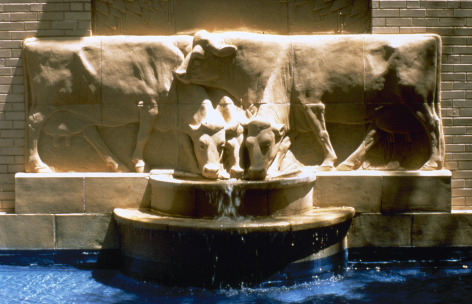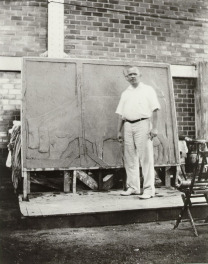
After nearly 30 years, water is flowing again from the fountain of Christian Petersen's "History of Dairying" sculpted mural. Photo by University Museums
AMES, Iowa – It is a historical work of art that is largely hidden from students, faculty and staff on the Iowa State University campus. Christian Petersen’s seven-panel mural and fountain “The History of Dairying” can be found along the east wall of the Food Sciences courtyard. However, an addition in 1986 enclosed the wall, making the courtyard accessible only through the Food Sciences building.
It is Ruth MacDonald’s hope to once again make the mural and courtyard – listed on the National Register of Historic Places – a focal point on campus.
“It’s an important part of our building,” said MacDonald, professor and department chair of food science and human nutrition at Iowa State. “In the early days it was used a lot for the president’s parties. They had weddings, lots of events happened out there because it was a very nice space. Over the years the space has lost its appeal and we want to try and make it a nicer area.”
For nearly three decades, the fountain that is the centerpiece of the sculpture has not worked. Water from the fountain would flow into a pool giving the impression that the dairy cows on the mural were drinking from a trough. But plumbing to the fountain was cut during the construction of the 1986 addition and ongoing structural issues with the pool made it inefficient.
“I would occasionally raise the question about filling in the pond and making it flat because it would collect water and leaves and looked ugly. If we did fill up the pond, it would leak down into the steam tunnels that run underneath the building,” MacDonald said. “I’ve always complained about it and just thought the courtyard in general needed a facelift.”
Partnership for preservation
With the help of University Museums and Facilities Planning and Management, MacDonald can now see water flowing from the fountain again. The mural was repaired and a new filtration system was installed to recirculate the water and make the fountain more efficient. Funding for the project was provided by the Office of the Senior Vice President for Business and Finance, and the College of Agriculture and Life Sciences will handle the annual maintenance.
“It is always satisfying to preserve or maintain, more importantly to maintain, an artistic legacy,” said Lynette Pohlman, director of University Museums. “Iowa State has done a great job of maintaining Petersen’s artistic legacy and then building on it with all the other art on campus.”

Christian Petersen working on his "History of Dairying" mural, 1934. Photo courtesy University Museums
Petersen’s sculpted mural is the first sculpture created as part of the federal Public Works of Art Project in Iowa during the Depression. Pohlman said Petersen’s art was part of Iowa State College President Raymond Hughes’ goal to create public art on campus.
“That program was important during the Great Depression because it employed artists, musicians and literary people. It was the jobs program; it was the TARP program of the 1930s,” Pohlman said. “For Iowa State, the two murals – both Petersen’s and Grant Woods’ – were really the start of a serious public art collection for the education of our students.”
To celebrate the newly restored mural, the Department of Food Science and Human Nutrition is hosting a reception from 4-6 p.m. on Friday, April, 19, as part of the VEISHEA festivities on campus. The public is invited to attend.
MacDonald wants this to be the first step in making the space more inviting and user friendly. That will take careful planning and funding because of the courtyard’s designation as a historic landmark. But MacDonald believes the preservation of the courtyard will be worthwhile.
“I would like to make it a nice space for classrooms to go out there or for students to go out and have lunch or for people to come by and enjoy the gardens, because I think it could be a nice garden space,” MacDonald said.

